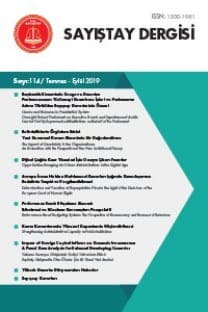AMU DENETİMİNDE PERFORMANS ÖLÇÜMÜ VE YÜKSEK DENETİM KURUMLARI (YDK) İÇİN GÜÇLÜKLERİ
RFORMANCE MEASUREMENT IN PUBLICAUDITING AND CHALLENGES FOR SUPREME AUDITINSTITUTIONS
___
- Akyel, Recai and Kose, H. Omer (2013), Auditing and Governance: Importance of Citizen Participation and The Role of Supreme Audit Institutions to Enhance Democratic Governance, Journal of Yasar University 8(32), 5495-5514.
- Baimyrzaeva, Mahabat and Kose, H. Omer (2014), The Role of Supreme Audit Institutions in Improving Citizen Participation in Governance, International Public Management Review Vol. 15, Iss. 2, 77-90.
- Bouckaert, Gert and Balk, Walter (1991), Public productivity measurement: Diseases and cures, Public Productivity & Management Review, 15 (2), 229-235.
- European Court of Auditors (2014), “Measuring your performance”, Presentation of the 25th June 2014 (updated), by G. Simpson, A. Bolkart, T. Lehtinen.
- Hood, Christopher (1995), The New Public Management in the 1980s: Variations on a Theme, Accounting, Organizations and Society, 20(2/3), 93-109.
- Horngren, C. T. (2004), Management Accounting: Some Comments, Journal of Management Accounting Research 16 (1): 207–211. doi:10.2308/ jmar.2004.16.1.207.
- INTOSAI (2016), Supreme Audit Institutions Performance Measurement Framework (Endorsement version), https://www.idi.no/en/idi-cpd/sai-pmf (Access date: 01.06.2020)
- INTOSAI (2019a), Supreme Audit Institutions Performance Measurement Framework Implementation Strategy 2020-2022, July.
- INTOSAI (2019b), INTOSAI P-12: The Value and Benefits of SAIs - making a difference to the lives of citizens, https://www.intosai.org/ fileadmin/downloads/documents/open_access/INT_P_11_to_P_99/ INTOSAI_P_12/INTOSAI_P_12_en.pdf (Access date: 22.05.2020)
- INTOSAI CBC (2007), Building Capacity in Supreme Audit Institutions: A Guide, INTOSAI Capacity Building Committee, DG Ref: 7509RB, National Audit Office.
- INTOSAI IDI (2012), Mapping of Tools for Assessing Performance of Supreme Audit Institutions, Volume 1 Report, 20/5/2012.
- INTOSAI IDI (2020), SAI Performance Measurement Framework, https://www. idi.no/en/idi-cpd/sai-pmf (Access date: 22.05.2020)
- Ketelaar, Anne (2007), Improving Public Sector Performance Management in Reforming Democratizers, DAIdeas, Democracy Briefs, Issue No 3, December
- Kontogeorga, Georgia (2013), Adapting Business Practices To the SAIs Environment: Towards A New Performance Measurement Framework, Journal Cour des Comptes Européenne, May, No 5. 2-4
- Otley, David (2003), Management Control and Performance Management: Whence and Whither?, British Accounting Review, 35: 309–326. doi:10.1016/j.bar.2003.08.002.
- Poister, Theodore H. (2003), Measuring Performance in Public and Nonprofit Organizations, Wiley.
- Pwc (2014), Metrics by design: A practical approach to measuring Internal Audit performance, September
- Schalock, Robert L. (2001), Outcome Based Evaluation, Kluwer Academic.
- Siverbo, S, Cäker, M. & Åkesson, J. (2019) Conceptualizing dysfunctional consequences of performance measurement in the public sector, Public Management Review, 21: 12, 1801-1823, DOI: 10.1080/14719037.2019.1577906
- van Loocke, Eddy; Put, Vital (2011), The impact of performance audits: a review of the existing evidence in Performance Auditing Contributing to Accountability in Democratic Government, edited by Londsale, J., Wilkins, P., Ling, T., Edward Elgar, UK, USA, 175-208.
- van Zyl, Albert; Ramkumar, Vivek; de Renzio, Paolo (2009), Responding to challenges in supreme audit institutions: Can legislatures and civil society help?, U4 Issue 2009: 1.
- van Thiel, Leeuw (2002), The Performance Paradox in The Public Sector, Public Performance & Management Review, Vol. 25 No. 3, pp. 267-281, Sage Publications.
- UN DESA (2007), Public governance indicators: A literature review, United Nations, Department of Economic and Social Affairs, ST/ESA/PAD/ SER.E/100. New York, NY: United Nations
- ISSN: 1300-1981
- Yayın Aralığı: 4
- Başlangıç: 1990
- Yayıncı: T.C. Sayıştay Başkanlığı
YÜKSEK DENETİM KURUMLARININ YARGISALİŞLEVLERİ VE INTOSAI STANDARTLARINDA YARGININTEMEL İLKELERİ
KÜRESELLEŞME VE SAVUNMA HARCAMALARIARASINDAKİ İLİŞKİNİN İNCELENMESİ
AMU DENETİMİNDE PERFORMANS ÖLÇÜMÜ VE YÜKSEK DENETİM KURUMLARI (YDK) İÇİN GÜÇLÜKLERİ
Farouk HEMICI, Georgia KONTOGEORGA
PANDEMİ SÜRECİNİN YÜKSEK DENETİM DÜNYASINA ETKİLERİ
İNSANİ GELİŞMİŞLİK ENDEKSİ İLE DOLAYLI DOLAYSIZ VERGİLER ARASINDAKİ İLİŞKİ: TÜRKİYE ÖRNEĞİ
Rabia Tuğba EĞMİR, İsmail CİĞERCİ
Hakkı Hakan YILMAZ, İbrahim AKDENİZ
AVRUPA SAYIŞTAYI İLE ÜYE DEVLET YÜKSEKDENETİM KURUMLARI ARASINDAKİ İLİŞKİ
